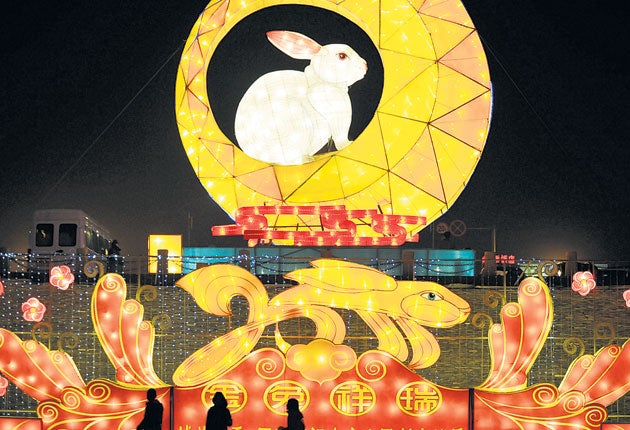Susie Rushton: All to play for in the Year of the Rabbit
Notebook

Your support helps us to tell the story
This election is still a dead heat, according to most polls. In a fight with such wafer-thin margins, we need reporters on the ground talking to the people Trump and Harris are courting. Your support allows us to keep sending journalists to the story.
The Independent is trusted by 27 million Americans from across the entire political spectrum every month. Unlike many other quality news outlets, we choose not to lock you out of our reporting and analysis with paywalls. But quality journalism must still be paid for.
Help us keep bring these critical stories to light. Your support makes all the difference.
Gentlemen of a macho disposition, look away now. We are about to explore a topic that even the average pink-clad, five-year-old girl might find nauseating: bunny rabbits. You'll be seeing a lot of these creatures this week, because festivities for the month-long Chinese Lunar New Year are about to commence. The Tiger era over, we are now about to enter the Year of the Rabbit.
In China, that means little kids in pink bunny outfits and ubiquitous images of white rabbits, but also predictions by economic commentators that China's fortunes will continue to "leap" ahead. Rabbits are infiltrating politics. Last week, the Chinese Communist Party censored a three-minute YouTube cartoon that told the story of a community of innocent rabbits rising up against an oppressive government of tigers – who drove over the bunnies in tanks. Plenty of Chinese are reportedly also planning to take the symbolism literally by buying a pet rabbit, causing animal protection groups to raise concerns that by the summer, abandoned bunnies will be left to hop streets across the Far East.
You can see why those owners tend to lose interest. Rabbits don't want to fetch sticks, or go for walks. They possess neither the independence of a cat nor the loyalty of a dog. For all my childhood devotion to the many rabbits I kept, in return I received only a twitching nose and the occasional quizzical glance. So what are rabbits good for? Not much, if you believe the Western view. They are cheap pets, or creatures to be used in laboratory tests, or farmed for fur and, less fashionably, for meat. Over here, they symbolise venality, either as the name for a best-selling designer vibrator (look it up) or the brief costume of the Playboy Bunnies (expect to see rather too much more of them, too, as Hefner's club re-opens in London's Mayfair).
But we shouldn't roll our eyes as the Chinese cuddle up to rabbits this month. A benign vulnerability is what makes these creatures appealing, and if that encourages a caring and altruistic attitude in children, this year it might just be worth buying a bunny.
Still labouring under those stretch fabrics
He certainly had gout, and commitment issues, but who knows whether Henry VIII possessed a pair of moobs? My guess is that he probably did – it's just that his doublet did a flattering job of concealing them. Ditto Winston Churchill, who presumably had at least a C-cup bust hidden inside his tailored suits. The historic female chest, too, was engineered with corsetry and boning to please the eye – all the Fifties pin-up girl needed was a really good bra.
In 2011, it seems we would rather mould our flesh than use clothing to improve its appearance. This week, it has been revealed that more British men than ever, unhappy with the fat on their chests, are opting for a "moob" job (up 28 per cent in the past year).
So, too, are British women more willing than ever to slice open their breasts for the promise of a big, bouncy chest. Celebrity culture is partly to blame for the rush to the knife (holiday snaps of Tony Blair and Jack Nicholson for the moobs, Christina Hendricks for the boobs). But I also think that Lycra, which really took off in the body-conscious late 1970s, is culpable.
Once, our "faulty" figures were sculpted by crisp cotton and clever tailoring that fitted, rather than exposed, lumps and bumps. Then stretch fabrics changed everything. Now everything from leggings and jeans to cocktail dresses is stretchy, and we are increasingly displeased to discover that our wardrobes cling in all the wrong places. Get a new wardrobe, not a new body!
In Japan, they know what not to do with gadgets
I am recently back from Japan, and though I didn't bring any gadgets home in my suitcase, I did return with an education in tech civility. Tokyo may no longer be the city of futuristic gizmos we in the West will only receive in five years' time – Apple's ascendance has put a temporary halt to that. But what is noticeably advanced are Japanese social attitudes towards using technology in public.
Nobody uses a phone in a train carriage (they go to the corridor to take a call). Smartphones for reading news, email, books and maps may be universally owned, but they are not placed on dining tables. Laptops are only discreetly brought out in public places, and are positioned to take up as little personal space as possible. You'll never hear a ringtone in public, let alone the leaking sound of somebody's iPod or, God forbid, a radio.
Yet this doesn't stop the Japanese from being enthusiastic consumers and users of technology. Quite the opposite – the integration of portable digital media into everyday life feels effortless. Meanwhile, back in Britain, with iPads now sliding off laps at every turn, BlackBerries tweaked feverishly and phone calls shouted without a thought for those nearby, we are blithely heading toward a world of Wi Fi-enabled hooliganism.
Join our commenting forum
Join thought-provoking conversations, follow other Independent readers and see their replies
Comments